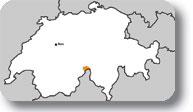
 |
Binntal Landscape Park |
Protected Area |
|
 |
|
Cultural Landscape |
|

|
Throughout the centuries, man has affected the landscape cutting forests, cultivating lands, building houses and roads. Therefore, our landscape has been created by man: it is a cultural landscape. Wilderness is today confined in isolated and not easily accessible places, secret and dangerous areas.
Albrunpass was a rather busy area in the past. At Schmidigehischere, in Binn, ruins of Celtic settlements have been found. In Twingi gorge, between Ausserbinn and Binn, the routes of the ancient Romand roads are still visible. Small roads, meadows, pastures, dry-stone walls, stables, and huts characterize the traditional cultural landscape and witness that the territory of Binntal Landscape Park has always been characterized by human settlements where men used to live a simple life, also made of hard work. The three Park Municipalities still maintain the attachment to the hard but genuine rural life. The ancient towns - with their houses made with larch wood darkened by the sea - have remained intact. The towns of Mühlebach, Ernen, and Grengiols, but also Schmidigehischere, Wilere, and Fäld are well preserved and beautiful to visit. Thanks to their extraordinary features, they have been included in the state list of landscape areas of national interest. The present generation is therefore obliged to continue to preserve this precious cultural heritage, so that also future generations can enjoy it. Of course, this is above all a duty of the Park.
|
Natural Landscape |
|
| Nature-lovers call Binn Valley "the valley of concealed treasures".
The international fame of the valley depends on its richness in minerals. Some of them have been given geographical names, like Lengenbachite, Wallisite, or Cervandonite. Further natural treasures are even easier to find. As a matter of fact, minerals are often very small and preserved under heavy earth strata. With flowers, you will not have such problems. Binntal Landscape Park is rich in flora, changing according to the season. Moreover, it boasts several rare species. Thanks to its natural untouched beauty and its richness in minerals and flowers, the valley has been included in the list of landscapes of national interest. In 1964, the Municipality of Binn had already signed a contract of environmental protection with "Pro Natura" and "Schweizer Alpenclub".
|
|
Strategy |
|
| A world of imposing mountains and an extraordinary cultural landscape: these are two of the several precious features of the Swiss mountain areas. But what can we do with all this? This question led to the idea of the Park establishment. The protection and safeguard of these unforgettable panoramas had to be balanced with economic development. Agriculture, tourism, and economy had to benefit from the landscape, without damaging nature. Today, this is something real, and we are working so that it will remain a reality also in the future.
Birth of the Park Project The project was born from the initiative "BLN-Land Schweiz" of BUWA. In 2002 a project for the region was created. The project involved the municipal area of Binn and the whole territory around the Municipalities of Ernen and Grengiols. These three towns are still today the main promoters of the project, including various concept and architectural projects promoting the conservation and development of the local nature, culture, and economy. The project is linked to the world of marketing and nature protection at a global level. |
|
Policy |
|
| Despite being rich in natural resources, Swiss mountain and rural areas are facing some important difficulties. One of the various strategies promoting structural changes is called "labelling". Besides the well-known product labelling (for instance, "organic"), the region labelling is gaining ground.
Regions like Binntal wish that a well-known label like "Landscape Park" could attract new economic drives. It is essential that the people living in the area decide which features and values should be represented by the label. |